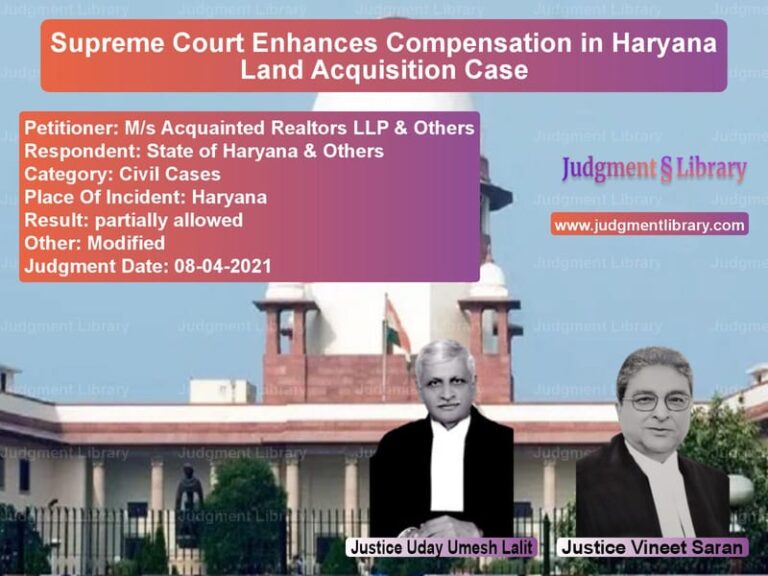Nagpur Improvement Trust Case: Supreme Court Decision on Land Development and Road Widening
The Supreme Court of India recently delivered a significant judgment in the case of Nagpur Improvement Trust & Ors. v. M/s Bombaywala & Ors. The case primarily revolved around the dispute concerning the implementation of a development scheme under the Nagpur Improvement Trust (NIT) Act, 1936, and the Maharashtra Regional Town Planning (MRTP) Act, 1966. The key issue was whether the internal road planned under the NIT Act could be overridden by the provisions of the Development Plan under the MRTP Act.
The appeals challenged the judgment of the Bombay High Court, which had quashed the demolition notices issued by the NIT, citing the need to conform with the development plan. The Supreme Court, however, ruled in favor of the NIT, asserting that the development plan under the MRTP Act supersedes the scheme sanctioned under the NIT Act.
Background of the Case
The NIT, through its 1964 scheme, had proposed an internal 15-meter road as part of the Abhyankar Road Widening and Buty Mahal Street Scheme. This was done to improve communication and facilitate traffic movement. However, after the enactment of the MRTP Act in 1966, the first final Development Plan for Nagpur was sanctioned in 1976, and this internal road was not included in it.
Over time, various land acquisitions, agreements, and revised plans led to further changes in the city’s development scheme. The NIT continued implementing its 1964 scheme, despite its provisions being absent from the sanctioned development plan under the MRTP Act. Consequently, demolition notices were issued to tenants occupying portions of the land.
Arguments Presented
Arguments of the Appellants (Nagpur Improvement Trust & Others)
- The MRTP Act overrides the NIT Act, and the final development plan does not provide for the internal road proposed in the NIT scheme.
- According to the Supreme Court’s decision in Manohar Joshi v. State of Maharashtra (2012), the development plan under the MRTP Act takes precedence over any prior town planning scheme.
- The Bombay High Court erred in ruling that the NIT was bound to implement its 1964 scheme despite the lack of a corresponding provision in the development plan.
- The High Court misinterpreted the law by holding that the NIT was obligated to implement the road unless the scheme was formally modified under the NIT Act.
Arguments of the Respondents (M/s Bombaywala & Others)
- The internal road was a crucial part of the 1964 scheme aimed at easing traffic congestion and providing better access.
- The NIT was statutorily obligated to implement its sanctioned scheme unless varied under Section 46 of the NIT Act.
- The tenants occupying the land were being unfairly displaced without an adequate alternative being provided.
- The development plan’s silence on the internal road did not mean that the scheme under the NIT Act could be disregarded.
Supreme Court’s Decision
The Supreme Court ruled in favor of the Nagpur Improvement Trust and set aside the High Court’s judgment. The key findings were:
- The development plan under the MRTP Act has overriding effect, meaning that the absence of a provision for an internal road in the plan makes it unnecessary to implement the same under the NIT scheme.
- The sanction of a layout plan and grant of building permissions by the NIT was valid and in accordance with the MRTP Act.
- The High Court erred in quashing the demolition notices issued by the NIT since the layout plan was in compliance with the applicable development plan.
- The subsequent modification of the scheme by deleting the 15-meter internal road was lawful.
Impact of the Judgment
This ruling reinforces the precedence of the MRTP Act over prior schemes under the NIT Act. It establishes that:
- Town planning schemes must align with the final development plan under the MRTP Act.
- Local planning authorities cannot implement provisions from older schemes that conflict with the sanctioned development plan.
- Developers and landowners can proceed with projects sanctioned under the MRTP Act without the constraints of outdated schemes.
Conclusion
The Supreme Court’s judgment in this case resolves a long-standing dispute concerning town planning and development schemes in Nagpur. By upholding the MRTP Act’s supremacy, the Court has reinforced a uniform framework for urban planning and development.
Petitioner Name: Nagpur Improvement Trust & Ors..Respondent Name: M/s Bombaywala & Ors..Judgment By: Justice A.K. Sikri, Justice Ashok Bhushan, Justice M.R. Shah.Place Of Incident: Nagpur, Maharashtra.Judgment Date: 22-01-2019.
Don’t miss out on the full details! Download the complete judgment in PDF format below and gain valuable insights instantly!
Download Judgment: Nagpur Improvement T vs Ms Bombaywala & Ors Supreme Court of India Judgment Dated 22-01-2019.pdf
Direct Downlaod Judgment: Direct downlaod this Judgment
See all petitions in Property Disputes
See all petitions in Landlord-Tenant Disputes
See all petitions in Specific Performance
See all petitions in Damages and Compensation
See all petitions in Judgment by A.K. Sikri
See all petitions in Judgment by Ashok Bhushan
See all petitions in Judgment by Mukeshkumar Rasikbhai Shah
See all petitions in allowed
See all petitions in supreme court of India judgments January 2019
See all petitions in 2019 judgments
See all posts in Civil Cases Category
See all allowed petitions in Civil Cases Category
See all Dismissed petitions in Civil Cases Category
See all partially allowed petitions in Civil Cases Category







